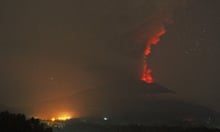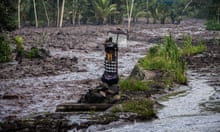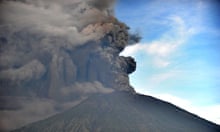A large eruption of Bali’s restless Mount Agung volcano could be imminent, Indonesian officials have said as they called for 100,000 people to leave the area.
So far, 40,000 people have been moved away from the volcano and tens of thousands of travellers have been stranded due to airport closures.
Mount Agung has been spewing volcanic ash with increasing intensity since last Tuesday. After confirmation that the volcano was shifting into the magmatic phase, authorities raised the warning level to the maximum of 4 on Monday morning.
Indonesia’s disaster mitigation agency (BNPB) has strongly urged people to immediately leave the designated exclusion zone, which has been extended to an 8-10km radius of the volcano.
“We ask people in the danger zone to evacuate immediately because there’s a potential for a bigger eruption,” said Sutopo Purwo Nugroho, a spokesman for the agency.
He said up to 40,000 people had been evacuated from the area and a further 60,000 also needed to move. The governor of Bali said later that 150,000 could be called on to leave.
“Not all residents have evacuated yet. There are those [who have not left] because their farm animals haven’t been evacuated yet. There are those who feel they are safe,” Sutopo said.
He said security personnel were trying to persuade people to leave voluntarily but that some could be evacuated by force.
Quick GuideMount Agung eruption
Show

Where is the volcano?
Mount Agung rises about 3,000m above Bali's Karangasem district, in the island's east. Bali lies within the so-called Pacific ring of fire, an area of high seismic and volcanic activity where thousands of tremors occur each year.
Has it erupted before?
Mount Agung's last major eruption in 1963 killed about 1,100 people and razed many villages. More than 50,000 Indonesians were evacuated in September this year when experts warned an eruption was imminent. About 25,000 people have been unable to return to their homes since then.
What is happening this time?
21 November – a minor eruption sent a plume of ash and steam rising about 700m. Volcanologists said it was caused by magma heating water (phreatic eruption). No alert was issued.
25 November – three minor eruptions sent a plume rising 4,000m and coated nearby villages in a layer of ash. An exclusion zone of 7.5km was put in place and some flights were diverted or cancelled.
26 November – Indonesia's Volcano Observatory Notice for Aviation updated to code red, predicting a further eruption with significant volcanic ash. Some flights were cancelled. Experts said the eruption was being driven by magma rather than steam.
27 November – Indonesian authorities raised the alert to the highest level and ordered people within 10km to leave as experts warned of an imminent risk of a larger eruption. Australia's Bureau of Meteorology said the ash plume had risen to 9,144m. Denpasar airport was closed for 24 hours.
How long will it last?
Australia's BOM expects eruptions and ash to continue for at least 24 hours. Indonesian government volcanologist Gede Suantika estimates Agung could spew ash for at least a month.
Authorities also warned of dangerous mudflows. Video released by the BNPB showed water and volcanic debris flowing down the slopes of Mount Agung as rain fell on the island.
Sutopo said people should stay away from rivers because mudflows could move rapidly and were a frequent killer during volcanic eruptions.
Instrumental measurement of Mount Agung began after the last big eruption in 1963, an event that lasted a year and killed more than 1,000 people.
As ash began to fall over her village of Jungatan in recent days, Nengah Wati decided to leave her home and seek refuge in the small fishing village and popular dive location of Amed.
The 73-year-old is now staying with her daughter-in-law Wayan Widarti. Direct views of the volcano from the shoreline were stirring Wati’s memories of the 1963 eruption.
“When she first arrived she kept looking nervously at Agung,” Widarti said. “She gets emotional when she thinks about it, but she says it was much more powerful and explosive back then.”
In the past few days the ash fall had been like snow in her village, Wati told her daughter-in-law, and they had to feed the cows banana leaves because the grass was covered.
Q&AWhat is happening inside Mount Agung?
Show
Increased seismicity (both in the number and intensity of earthquake occurrences) in recent months is a sign that the magma that has been accumulating for decades is rising from deep within the earth. As this mixture of molten rock and gases rises, the gases form bubbles, building pressure inside Agung. If the gas cannot escape, a violent eruption can be expected. Ash, which is fragmented lava, has already been emitted, as has a column of steam produced from water heated by the magma. Mudflows and signs of molten lava at the summit have also been spotted.
Even though the home of Widarti’s in-laws is situated within the extended danger zone, the rest of the family was yet to evacuate. Widarti said they were reluctant to leave their home and possessions behind.
Putu Sulasmi had fled with her husband and other family members to a sports hall that is serving as an evacuation centre. “We came here on motorcycles. We had to evacuate because our house is just three miles from the mountain. We were so scared with the thundering sound and red light,” she told Associated Press.
The family had stayed at the same sports centre in September and October when the volcano’s alert was at the highest level for several weeks but it did not erupt. They had returned to their village about a week ago.
“If it has to erupt, let it erupt now rather than leaving us in uncertainty. I’ll just accept it if our house is destroyed,” she said.
An airport spokesman, Air Ahsanurrohim, said 445 flights had been cancelled, stranding about 59,000 travellers. The closure was in effect until Tuesday morning, and officials said the situation would be reviewed every six hours.
Bali is Indonesia’s top tourist destination, with its Hindu culture, surf beaches and lush green interior attracting about 5 million visitors a year.
Some flights to and from Bali were cancelled on Saturday and Sunday but most had continued to operate normally as the towering ash clouds were moving east toward the neighbouring island of Lombok.
Q&AHow have you been affected by the Bali volcano evacuation?
Show
If you have been affected by the events in Bali you can tell us about it using our encrypted form, or by sending your pictures and videos to the
Guardian securely via WhatsApp by adding the contact +44(0)7867825056.
We will feature some of your contributions in our reporting.
Your safety is most important, so please ensure that you’re taking this into account when recording or sharing your content.
Bali’s governor, Made Pastika, said he was urging hotels on the island to allow stranded foreign tourists to stay free of charge, especially cash-strapped backpackers.
“Yes, I’m asking. This is a disaster. Especially for those who have spent all their money,” he said. He was coordinating with the immigration office to ensure the extension of visas for tourists forced to overstay due to the volcanic activity.
Brandon Olsen, a Canadian tourist stranded at Bali’s airport with his girlfriend, said: “We now have to find a hotel and spend more of our money that they’re not going to cover us for when we get home, unfortunately.”






